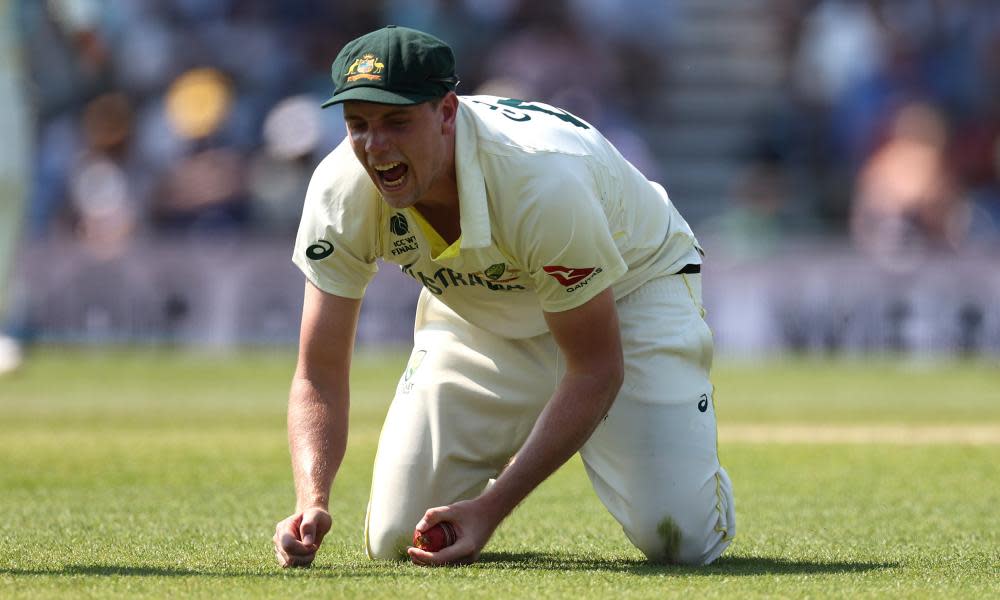Despite the fury, Cameron Green’s catch leaves no grounds for complaint

As the second session wound onwards on the fourth day of the World Test Championship final, the Oval was a cheerful place. On a perfect, warm afternoon, the bays that were largely full of India supporters erupted after every boundary as Rohit Sharma and Shubman Gill made a bright start to a massive run chase.
Soon it was much less bucolic, with a fair share of those fans shouting “Cheat!” at the Australian all-rounder Cameron Green. Others lined up to give him a gob-full as he climbed the stairs through the crowd at tea. Fielding in the gully, Green’s crime had been to throw out his hand for a low catch off Gill that the TV umpire, Richard Kettleborough, ruled fair.
Related: Pat Cummins loses cool but not threat as Australia’s attack excels again | Geoff Lemon
We may as well get into the detail of Law 33, because the months to come will bring more low catches and the same feverish round of disagreements. They will centre on whether a ball touched the ground before a catch was taken and so whether a dismissal should stand. Let’s put an argument on the record.
First, it is significant the old “soft signal” is gone. That meant a standing umpire unsure about a catch could indicate whether they thought it was likely to be out or not, before asking the TV umpire for evidence to overturn that call. These days we go straight to the TV umpire, who is fully responsible for the ruling.
Low catches cause such discord because there is a gap between the way the laws are written and the way cricket is played and umpired. The text says that a batter is out if a ball is held as a fair catch “before it touches the ground”.
A fair catch starts “when the ball first comes into contact with a fielder’s person and shall end when a fielder obtains complete control over both the ball and his/her own movement”.

Control is interpreted as the point when the movement that took the catcher to the ball has finished. Someone diving, sprawling or rolling has to become still, or stand, or resume walking or running normally. So it’s fair enough on reading the law to think that if any part of the ball brushes the ground during that process, the catch is void.
The problem is that cricket has never been umpired that way. On the field, these decisions are determined by whether the ground has contributed to the catcher gaining hold of the ball.
Say you lunge forward for a catch. Put your hand sideways, like holding a drink can. Imagine a cricket ball instead. You could be gripping it rigidly, but the circle of your little finger and thumb leave space for the ball to stick out. If that part of the ball touches ground while you slide forward, the ground hasn’t helped you take the catch. Any umpire would give that out.
Or picture the ball with your palm up. When you curl your fingers, there will be gaps between them, because that’s how spheres work. If you press that hand hard against the ground, the ball will make some contact. But it is still completely in your grasp.
Most contentious low catches, including Green’s, are like the latter. Fingers splay, allowing contact. But the ground has not helped gain control of the ball. The ball would be held even if the ground wasn’t there. A catch is not out when ground contact has come first, the ground helping deflect the ball into the hand, or if control of the ball was slipping and the ground helped regain it.
This year’s Sydney Test had three contentious examples. South Africa’s Simon Harmer had his fingers on the ground at slip when a ball bounced off them into his palms. Steve Smith took two low snares where some part of the ball touched ground despite his grasp. Kettleborough was the TV umpire in that match and gave all three not out.
It spawned broad confusion that such an experienced umpire was now following the letter of the law rather than the interpretation of precedent. Mark Waugh knows more about slip fielding than most people and said that all three catches would have stood at any other time. There is a strong case that Law 33 needs to be clarified, but not that its enforcement should change.
Maybe Kettleborough got a corrective, or self-issued one, or perhaps Green’s catch in this match offered fewer angles of doubt. Either way, it shows the ball going into his hand inches above the ground, then the hand descending.
Even the photograph zoom presented by those who disagree shows three fingers and a thumb firmly locked around the ball.
The ball is in his grasp and incidental ground contact does not influence that at all. It is the way the law was interpreted at suburban ovals around the world last weekend, it will be next weekend, and it should be no matter who is batting in any Test match from here. How was that? Out. Who’s in next?

 Yahoo News
Yahoo News 
